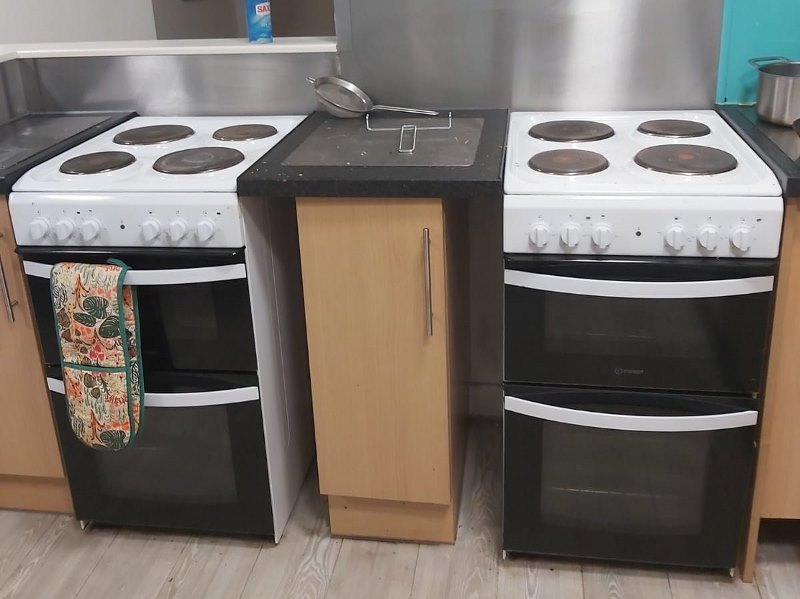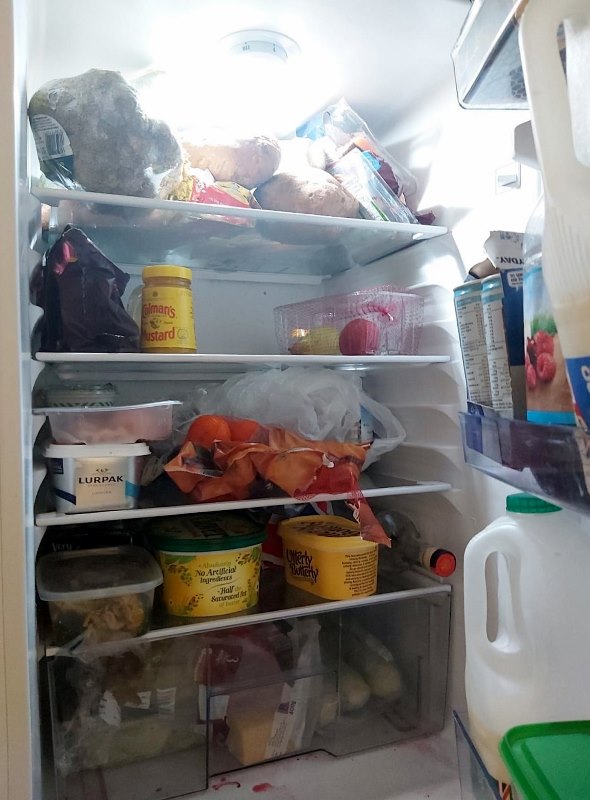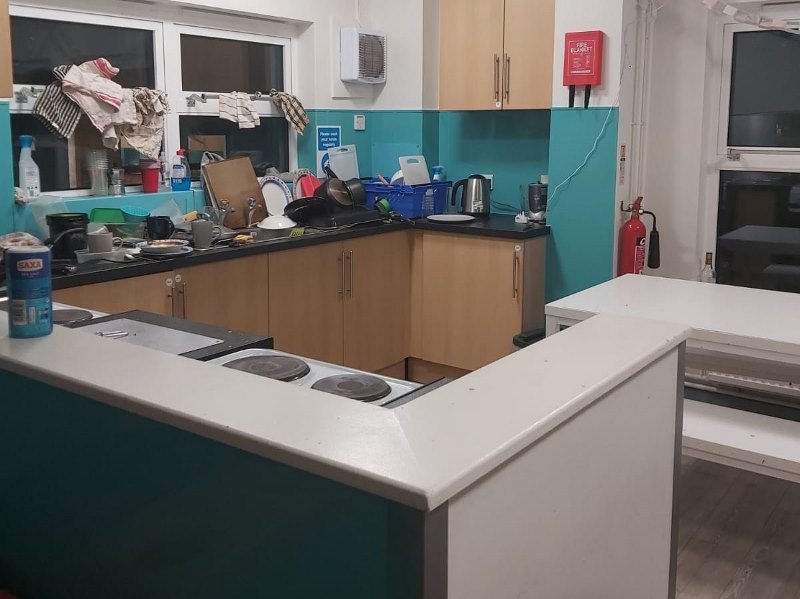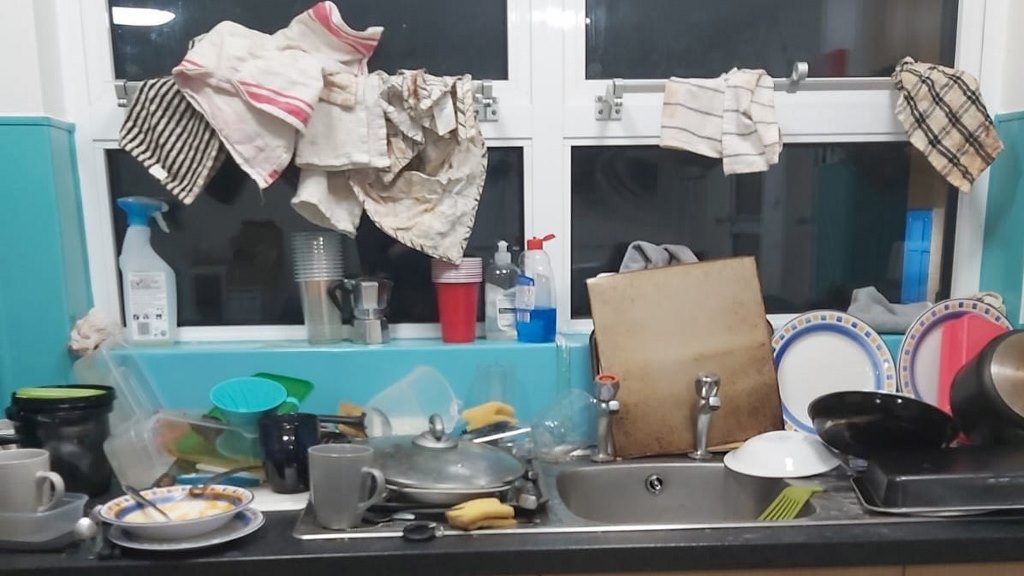One of the biggest challenges facing students when they attend university for the first time, is cooking. Specifically, cooking in a shared kitchen. After all, students tend to arrive at university after 18 years of having their evening meals prepared by their parents…
Most students, of course, will be able to cook to some extent. Some may even have a catering GCSE, to prove that they can cook! Very few, however, will be used to preparing and cooking an evening meal, day in and day out, for weeks at a time. And virtually none of these students will be familiar with cooking in a strange kitchen, with people they’ve never met, using shared facilities.
So… good luck with that…
For some people, however, cooking in a shared kitchen is something that can be avoided. At least, it can be avoided during their first year of university. For example, during my first year at university, I never set foot in the kitchen on my floor, much less cooked in it. This was because my particular Halls of Residence was attached to the dining hall. And, given this location, I’d opted to buy into one of the offered dining packages. As such, I had a voucher for all my evening meals throughout the entirety of my first year.
And this type of arrangement is still available in universities today. My older daughter, Emma, was offered this option with some of the accommodation choices for her first year at the University of Bath. She declined… Mainly because hers is a four year course and she worked out that it would be cheaper to cook for herself. Emma is determined to keep her debt to a minimum.
I, on the other hand, attended University at a time that the Government still paid you to do so. This meant that debt wasn’t so much a concern for me. I can’t remember the costs of the meal package, but it must have been reasonable because I left university debt-free. Well, apart from the inevitable overdraft at the bank.
In contrast, there is no way that Emma will leave university owing less than £50,000 ($69,200).
Which means that she’ll be cooking in a shared kitchen from day one.
And, to be fair, this is hardly the end of the world. Not least because, after that first year at university, she’ll be living off-campus. Which is to say, in a shared student house. At which point, cooking in a shared kitchen becomes an inevitability. Well, unless you’re sufficiently well-funded to live on takeaways…
And, as we’ve established, Emma is not so funded.
Which is why we made some plans before she left for Uni.
Firstly, we researched the area around the university and found which was her closest big supermarket. And, when it comes to supermarkets, the bigger the better. Bigger stores offer cheaper food. They also offer more ranges of foods, including greater variety of that chain’s budget options. Additionally, larger stores tend to have more reduced items, on a more regular basis: foods that are close to their sell-by date.
As a student, it’s important to know what colour the ‘reduced’ stickers are for your particular supermarket. Once you get your eye in, you can spot these on the shelves at a dozen paces! And don’t be fooled by the ‘reduced’ sections on certain shelves. Sure, there are reduced items here, but that doesn’t mean there aren’t others in their normal homes around the store. When I was a student, I used to love hunting through my local Asda, snapping up bargains! It was a free sport.

Image by Gerd Altmann from Pixabay
Emma’s local supermarket is a Sainsbury’s…!
This is a bit of a shame, because Sainsbury’s is one of the most expensive supermarkets. It does, though, have a number of low-priced budget ranges:
- Basics – kitchenware
- Daily’s – bread and cereal
- Greengrocer – chilled and frozen fruit and vegetables
- House 247 – for household and cleaning products
- Hubbard’s – cans, bottles and packets of shelf items
- Imperfectly Tasty – fruit and vegetables
- J. James – eggs, and chilled and frozen meats
- Just Snax – crisps and nuts
- Lovett’s – chocolate, biscuits and desserts
- Mary Anne’s Dairy – dairy products: cheese, yoghurts, etc
- Stamford Street – chilled and frozen ready meals
Some, or all, of these brands used to come under the ‘Basics’ range. I don’t know why there’s been this change but it’s a shame, because the ‘Basics’ brand packaging was really easy to spot on the shelves. If you search Basics on the Sainsbury’s website, some products from the above ranges do come up. However, searching by a given brand name gives you more returns.
Interestingly, neither the Lovett’s Milk Chocolate or the Lovett’s Dark Chocolate come up if you search for Lovett’s. They do, however, come up if you search for Basics. And they’re worth looking for, because they’re 100g bars of pretty nice chocolate, for 30p each.
That’s only £3 ($4.15) for a full kilo (2.2lb) of good chocolate…!
Anyway, I fear that I’ve been seduced off course somewhat.
My point is, if you do your research you’ll find that every supermarket has a range of student-priced foods. And, overall, it’s good food. I mean, if you’re buying meat, it won’t be a lean cut. Frozen minced beef, for example, is likely to be in the 20% fat range. Chicken is going to include the skin and bones. Of course, the fat and the skin is where you find all the flavour. But it’s also where all the calories are…
After our online research, Emma and I went to the local Sainsbury’s, here at home, and had a good look around. We hunted down the locations of the various products in the store. And, because supermarkets try to keep all their stores in the same format; if you’ve found something in one store, you’ve found it in all stores.
Which is great, but only half the battle. Sure, Emma now knew what she was going to cook. She just didn’t necessarily know how she was going to cook it. I mean, her GCSE catering final prepared her very well to cook a three-course celebration meal in a couple of hours…
This, sadly, would not help much when it came to: cooking for one person; when there are 12 other people trying to do the same thing, and; in a kitchen with 8 hob rings, two ovens, two grills and a microwave.

No, to be able to navigate her cooking in a shared kitchen like that, Emma was going to need a little something extra…
So I wrote her a cookbook!
Well, it’s only actually an eight page Word document that I called, University Cooking Guide. And I didn’t put any pictures in it… But it amuses me to call it a cookbook, so I shall continue to do so.
I also did an Excel Shopping List spreadsheet of the key items from the various ranges that I listed above. Or, at least, the key items that would be available at what would be her local store. The Bath Sainsbury’s turned out to be smaller than our local one. I’ll admit that I didn’t see that coming.
The spreadsheet includes: the food type; the weight of each item; the cost of each item, and; the value of each item (price per 100g). This is not only to help Emma maintain a financial budget, but also a dietary budget. When I was at university, I ate far too much fatty and sugary foods, which marked the start of a lifelong battle with my weight. Hopefully, the way the spreadsheet is arranged will allow Emma to avoid following in my footsteps.
So, armed with some suggestions of what she should be cooking in her shared kitchen, we took Emma to university. We even stopped at the Bath Sainsbury’s on the way in. And, here, Emma kindly allowed me to pay for her purchases…
She even allowed me to carry them into the kitchen for her!
And that was the first time she’d actually seen her kitchen. This hadn’t been one of the accommodation blocks we’d looked at, when we’d visited during the university selection process. And you can’t really get a good idea of the dimensions of a place from a virtual tour. Thankfully, Emma seemed happy enough with it. (I thought it was far too small for 13 people!)
One thing the space had plenty of, was cupboard space. Even better, each student had their own allocated (labelled) cupboard. As such, Emma was able to pack away all of her ambient temperature food, as well as her kitchenware.
After that, though, things became more complicated…
There were two large fridge-freezers, and one much smaller fridge. The small one was the sort of fridge that’s designed to fit under a kitchen counter. Only, this one was free-standing by a sofa. And it did have one of those little freezers boxes at the top. You know, the ones with the plastic door that don’t have much space and never really freeze anything properly? Yeah, one of those!
The fridge part of the big fridge-freezers, meanwhile, had five shelves each, if you included the vegetable drawer. The small fridge had three shelves. And, with 13 in the building, that was room for a shelf each. The shelves in the small fridge were a little smaller, but it seemed workable. Especially if there was a bit of give and take in terms of the door spaces of the various fridges.

The freezers, however, were another story…
The freezer sections of the big fridge-freezers also had five shelves. The small fridge, of course, had nothing of value to add to the equation. This meant that 13 strangers were going to have to share 10 shelves.
You might argue that the university had done this deliberately, to force the housemates to communicate. Maybe even as a planned move to build conflict resolution skills.
The alternative argument, of course, is that the university was just too stingy to replace that under-counter fridge with a third, large fridge-freezer. Had the university opted to provide three of these large fridge-freezers, everyone could have had an allocated shelf in a fridge and an allocated shelf in a freezer.
But there weren’t allocated shelves. And the housemates never had a proper discussion about space in the fridges and freezers. So the inevitable happened…
What started off as people self-allocating their own spaces in the fridges and freezers, soon became a free-for-all. It’s probable that part of this is down to the use of supermarket delivery services. But, then, shopping in such a way is clearly the safest option during a pandemic lockdown.
Deliveries, though, aren’t free unless a certain amount is spent. Which led to groups of the housemates ordering their groceries together, and then sharing a delivery slot. The result of which was a mass of fridge and freezer food arriving at once. At which point it’s all crammed into whatever space is available.
Needless to say, it doesn’t take long before filling the fridges and freezers in this manner becomes the norm. People will buy to fill the perceived available space. And, as we all know from personal experience, unless you’re very careful, you always end up getting more than you need…
And, if you’re not part of the group that just had their shopping delivered; you’re not going to have space for any food for a couple of days…
A lot of the recipes in Emma’s cookbook rely on the availability of frozen veg. After all, the easiest way to ensure you’re getting enough vegetables in your diet is to throw a couple of handfuls of (defrosted) frozen veg into whatever you’re cooking. It doesn’t really matter if the veg goes into the pasta or the sauce, as long as it’s only in there for a couple of minutes. The same it true if you’re cooking couscous, rice, spaghetti or even spuds. It’s just a simple and healthy fix.
Unless you don’t even have room in the freezer for a bag of veg!
Then it gets a little more tricky.
But, assuming you actually have something to cook, the next question is: when do you cook it…

Most student cooking is done on the hob or the stove. Which means that every night the eight available hob rings are going to be in hot demand! And with the best will in the world, there is no way for 13 people to make 13 meals at the same time, using only eight hob rings. After all, some meals will require two or more hobs.
That said, if you allow 20 minutes and two hobs a person, 12 people can get through that kitchen in the space of an hour. And if the thirteenth person uses the microwave, the entire household can successfully be cooking their evening meals between 5:30 and 6:30 pm, in that tiny shared kitchen. I mean, sure, it might take a bit of coordination, particularly in terms of food prep. Also, you’d have to be pretty chummy with each other. But it can be done.
Or, at least, it could be done, if there was more than one sink…!
Because, and after all my concerns about the size of the kitchen, the biggest stumbling block in Emma’s experience turns out to be the sink. You see, some of the housemates prefer to keep it full of hot, soapy water, so they can wash up as they go. Other housemates, however, want the sink to be clear, so they can drain things like pasta and vegetables.
The net result is the sort of carnage you can see in the cover phtoto!
And that photo was taken after the cleaners had been in!
So it’s just as well that the cleaners come in twice a week.
Mind you, the cleaners only clean the communal areas, and, even then, just the areas that they can see. They ‘clean’, not ‘tidy’. As such, if the kitchen work surfaces are covered in dirty plates, the work surfaces don’t get cleaned. Emma’s solution to her part in all this, is to take her kitchenware back up to her room to wash up. Fortunately, every student has a sink in their room. And every student was provided with a washing-up bowl, at the start of the year…
So, Emma puts those two things together, and avoids having to go near the festering heap by the sink. Which is why none of her kitchenware has been broken. It’s probably also why she hasn’t had any food poisoning…
Or tetanus!
Cooking in a shared kitchen is never an easy thing. But its a part of most students’ lives and needs to be embraced and overcome. Of course it helps if everyone is mindful of everyone else but life isn’t always like that. Some people need to be more thoughtful of the other people around them, before anything needs to be said. Other people need to develop the skills necessary to allow them to get the most out of the cooking they want to do.
After all, there’s always room to improve on communication and negotiation skills. For all of us! Even so, maybe try and have these conversations earlier, rather than later.
All of which means that; negotiating your way to getting your cooking done in a shared kitchen, turns out to be good practice for later life.
